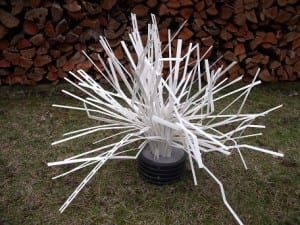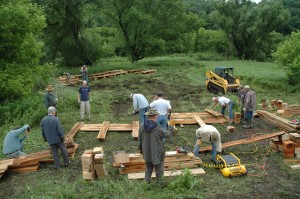GREG WAHL-STEPHENS
Logs have been fastened to the Upper Washougal River in recent years using a variety of methods, including bolts and chains and a binary glue.

GREG WAHL-STEPHENS
Glenn Saastad, a project coordinator with the Lower Columbia Fish Enhancement Group, says the third phase of the group’s Upper Washougal River restoration should wind down by fall.
Just below the popular swimming spot known as Naked Falls, the Upper Washougal River navigates an unusual landscape. About a dozen logs, bark mostly stripped, lie fastened to the river’s bare rocky bed in a seemingly random arrangement.
Glenn Saastad doesn’t see it that way.
Standing in the middle of the low-running river this week, Saastad looked into the future. He described a mix of natural gravel — perfect for salmon spawning grounds — among sediment gathered on each side. He saw slow-moving pools of water formed behind the logs. He saw riparian plants dotting the river’s path.
All of that could take five years or more to materialize. But it’s part of a carefully planned, fish-friendly vision that the Lower Columbia Fish Enhancement Group has worked from to transform the Upper Washougal since 2004. The third stage of the sweeping project — already starting to see results — is set to finish by this fall.
“We’re not doing anything that Mother Nature wouldn’t have done,” said Saastad, the project coordinator. “We’re just doing a sped-up version.”
Leading the effort is Tony Meyer, executive director of the group for the past 10 years. The $800,000 project has covered about five miles of the river so far, he said, mostly where impacts to roads and residents is minimal. Many other parts of the Upper Washougal could use some help as well, he said.
“The area we’re addressing is actually quite small,” Meyer said.
River ‘scoured out’
Logs are the main tool the project uses to restore complex natural habitat to the Washougal River. They’re also the main reason it was wiped out in the first place.
In the late 1800s and early 1900s, the logging industry functioned under a very different set of rules than it does today. Back then, loggers used “log drives” to move timber by building dams, then sending a torrent of water and felled trees down the river. The process also carved away many of the natural features fish depend on, Saastad said.
“All life is basically scoured out,” he said.
By putting fixed logs back in the river, the fish enhancement group is creating a system of anchors that collect gravel for spawning beds and add complexity to the flow of the river. In the high-flowing winter and spring months, the logs are submerged in water while that process takes place. Saastad hopes they’re eventually buried by natural ground cover in a new landscape.
Just as important are the changes in flow that result from the added terrain, Saastad said. Forming pools behind logs gives fish a respite from water current as they work their way upstream to spawn, he said.
“They need cover,” Saastad said. “They need those pools and those holes so they can make that trip. It’s a grueling trip.”
The goal of restoration remains the same, but the methods used in the project have evolved over the years. Crews have used everything from chains and bolts to a binary glue to attach logs to the river bed.
Not everything has worked. Smaller logs fastened early on have since begun to rot, Meyer said. The group even tried setting down boulders at first, he said. Turns out, they didn’t last very long.
“The river just pushed the boulders out,” Meyer said. “Just pushed them on down the river.”
Most of the logs used now measure more than 60 feet long, and at least a few feet in diameter. They’re fastened strongly enough to withstand a 300-year flood event, Saastad said. Actually attaching them are inmate crews from the Larch Corrections Center.
Bolting logs to a river bed isn’t a typical strategy for habitat restoration. Meyer said it started with his fish enhancement group before being tweaked in recent years.
“It’s a pretty new, innovative approach,” said Dave Howe, a regional habitat program manager with the Washington Department of Fish and Wildlife.
The condition of the Upper Washougal leaves no other choice, Howe said. With the river bed scraped completely down to bare rock, bolting and attaching log jams is the only way to get the features to hold, he said.
The unique project navigated several layers of review from various jurisdictions before taking off. It wasn’t always an easy sell, Meyer said.
The group now works closely with those agencies, and has found favor as it works a wide variety of projects stretching from the Bonneville Dam to the Washington Coast.
“The Lower Columbia Fish Enhancement Group is really one of the key restoration entities here in Southwest Washington,” Howe said.
Seeing results
In just a few short years, the project has produced noticeable changes to the Upper Washougal River, but not always what Meyer and Saastad had envisioned.
Some spots haven’t replenished gravel cover as fast as anticipated. Other spots, like one log jam near Dougan Creek Campground, have piled up much more than expected at a narrower portion of the river. Crews are now working about 20 miles upstream from Washougal.
“You have to kind of picture it in your head,” Saastad said of the planning process. “You don’t always get the result you expect.”
The work is always at the mercy of the weather. Crews operate in a short time window that only lasts from about July until October, Saastad said. By then, the river level comes back up and makes work impossible.
The Fish Enhancement Group has put close to 160 logs into the Upper Washougal this year. Next year likely won’t be as ambitious, Saastad said, but the group hopes to get a couple more years’ work out of its grant from the state Salmon Recovery Funding Board, even as Phase 3 winds down this fall. For a group that relies heavily on state and federal grants, making dollars last is key, Meyer said.
The Upper Washougal work has produced results so far — Saastad and Meyer said they’ve already seen increased salmon activity that wasn’t there several years ago.
The project is also unquestionably aggressive, reshaping the river in a short time period. But Saastad shrugs at the notion that it’s too heavy-handed.
“I don’t think it’s heavy-handed enough,” Saastad said. “The salmon are basically going to die off unless we do something.”
See the dozens of unique artificial fish habitat models, fish attractors and fish cover used at fishiding.com, the industry leader and only science based, man made and artificial fish habitat, proven to provide all fish with cover they prefer to prosper.
eric.florip@columbian.com.









